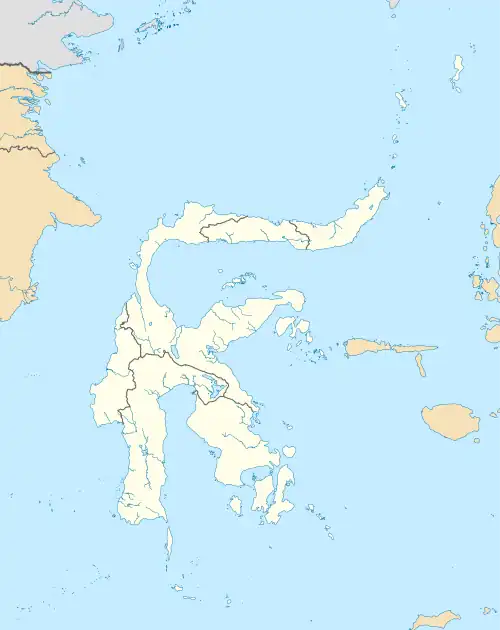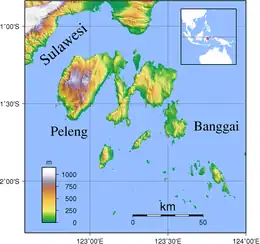 Peleng | |
| Geography | |
|---|---|
| Location | South East Asia |
| Coordinates | 1°24′S 123°10′E / 1.400°S 123.167°E |
| Area | 2,488.79 km2 (960.93 sq mi) |
| Highest elevation | 1,100 m (3600 ft) |
| Highest point | Unnamed |
| Administration | |
| Province | |
| Demographics | |
| Population | 123,580 (mid 2022 estimate[1]) |
| Pop. density | 49.65/km2 (128.59/sq mi) |

Peleng is an island off the east coast of Sulawesi, Indonesia and is the largest island of the Banggai Islands (Kepulauan Banggai). It is surrounded by the Banda Sea and Molucca Sea and has an area of 2,488.79 km2 (including offshore islands).
Peleng Island comprises the Banggai Islands Regency (within Central Sulawesi Province), which also includes some 440 small islands around the coast of Peleng, of which the largest are Bangkalan and Bakamanpauno Islands off the north coast of Peleng. Some of the smaller islands to the south of Peleng which were formerly part of the Banggai Islands Regency were removed in 2013 to form a separate Banggai Laut Regency; these comprise Banggai Island itself, Bowokan, Labobo, Kebongan, Kotudan, Tropettenando, Timpau, Salue Besar, Salue Kecil, Masepe, and Bangkulu.
In January 2020 a paper published in the journal Science documented the discovery of 10 new songbird species and subspecies, nine of them found in Peleng.[2]
Inhabitation
The majority of people on this Peleng Island make their living planting coconuts, sweet potatoes, or fishing.
The island is divided into 12 districts (kecamatan), each with the district capitals on the island. The island's largest towns are Basiano and Bonganang.
List of towns
- Basiano
- Bongangang
- Bulagi
- Lolantang
- Lukpenenteng
- Luksagu
- Pelei
- Mumulusan
- Salakan
See also
References
- ↑ Badan Pusat Statistik, Jakarta, 2023.
- ↑ A lost world in Wallacea: Description of a montane archipelagic avifauna, Frank E. Rheindt1, Dewi M. Prawiradilaga, Hidayat Ashari, Suparno, Chyi Yin Gwee1, Geraldine W. X. Lee1, Meng Yue Wu1, Nathaniel S. R. Ng, Science 10 Jan 2020. Vol. 367, Issue 6474, pp. 167-170,DOI: 10.1126/science.aax2146, https://www.science.org/doi/10.1126/science.aax2146